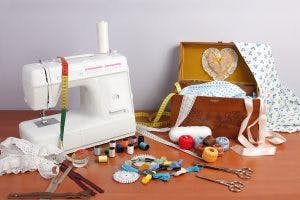Sewing Projects · Copyright © 2024
How To Set Up A Sewing Machine
By Jan Duncan
The art of sewing includes a wide range of skills, such as learning how to set up a sewing machine. The specifics regarding your machine will vary, depending on the manufacturer and model you have selected. However, there are a few basic things common with all machines.
If you have purchased a used machine, take it to your local sewing machine shop to have a complete maintenance check done. They will make sure that it is clean and properly lubricated. While those with a new machine can skip this step, regular professional cleanings will extend the life of your machine.
The choices you make when setting up the machine will be based on several factors, including the type of fabric you are sewing. Ball point needles are used for knits whereas woven fabrics require a sharp point to make a clean puncture.
The size of the needle will depend on how many layers of fabric and the thickness of each. For denim, upholstery and other thick fabric types, you will need a needle capable of sewing the material without breaking. However, a bigger needle is not always better. If you use a large needle on light fabrics, you will have oversized holes, skipped stitches and other potential problems. Quite often, pattern makers will provide suggestions based on the fabrics used in the design.
Choosing the appropriate thread for your machine is equally important. In addition to color concerns, the thread should be checked for strength and compatibility. Avoid old thread because it is more likely to weaken and break, ruining your hard work.
Use your machine to create as many bobbins as your project will need. This prevents stopping and starting throughout the project to take care of the inevitable need. If you are using a common color, you can easily use any leftovers on future projects.
Make sure that the area around your sewing machine is clear so that you have ample room to move the project as you work. Ensure that the cords will not interfere with you, including the one leading to the foot control.
Many modern sewing machines are self-threading, though not all. If you have to thread the machine yourself, read the directions completely before attempting to start. It is vital that you have everything in proper position or you will end up with incorrect tension or other problems.
Holding onto the top and bobbin threads, make some practice stitches on some scrap fabric from your project. Inspect both sides to be certain everything is even and smooth. Adjust the thread tensions until you are able to consistently get clear stitches.
Problems can also result from incorrectly installed bobbins, particularly in older model machines. Before you adjust the tension too much, take the bobbin out and carefully place back in the unit, taking care to wind the thread through the appropriate locations.
Learning how to set up a sewing machine will make it easier and faster for you to complete future projects. Make note of any complications and how you resolved them for future reference. Then, you can enjoy sewing new projects, from clothing to home decor!
Menu
Legal Pages
Categories


